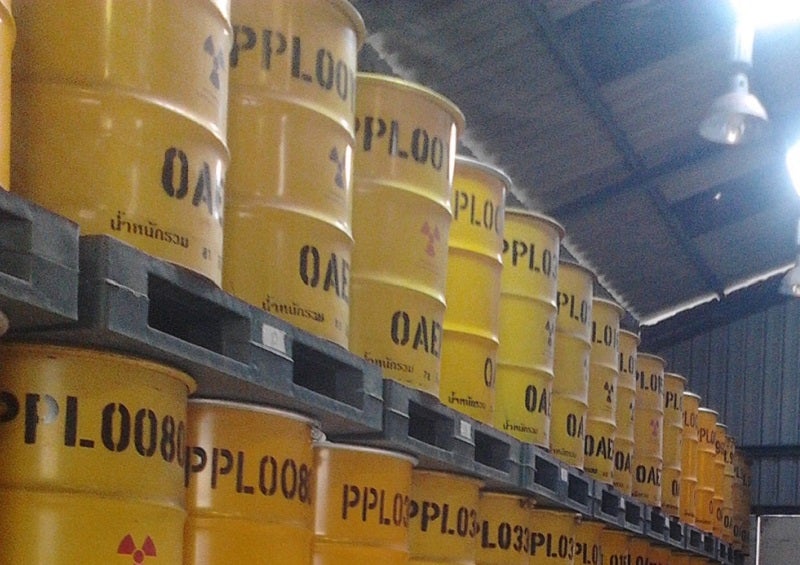
Proponents of nuclear power point to the fact that it produces fewer emissions than fossil fuels and is more reliable than renewable sources like wind or solar, which are dependent on favourable weather. However one significant side effect of nuclear power plants is the production of nuclear waste.
Contrary to what may be popular belief, nuclear waste is rarely a glowing green liquid, and mostly has low levels of radioactivity, with over 90% of the world’s nuclear waste considered to be at a low level.

Discover B2B Marketing That Performs
Combine business intelligence and editorial excellence to reach engaged professionals across 36 leading media platforms.
According to a recent article from the Nuclear Decommissioning Authority (NDA) in the UK, the world currently has 22,000m3 of high-level waste (LW), 460,000m3 of intermediate-level waste, 3,479,000m3 of low-level waste and 2,356,000m3 of very low-level waste, alongside 370,793 therms (tHM) of spent fuel. With the amount of nuclear waste being produced only increasing each year, what is the best way of dealing with this hazardous, mostly solid, material?
Going underground
With around 75% of the country’s energy produced from nuclear power, France has the second-largest nuclear fleet in the world behind the US.
It also leads the way worldwide for dealing with nuclear waste, with the IAEA stating in May 2018 that the country’s National Radioactive Waste Agency (ANDRA) had a “comprehensive commitment to safety with a responsible approach to the management of radioactive waste and spent nuclear fuel.”
One of the processes includes using recycled nuclear fuel, which the World Nuclear Association states forms 17% of France’s electricity.

US Tariffs are shifting - will you react or anticipate?
Don’t let policy changes catch you off guard. Stay proactive with real-time data and expert analysis.
By GlobalDataThis waste first has to be cooled for several years before in water pools, which in the process creates intermediate and high-level waste. These materials are then turned into an “insoluble, solid waste form” in a process known as vitrification, where it is mixed with glass at a temperature of 1200 degrees centigrade. It is then stored in stainless steel containers and allowed to solidify.
Vitrification is a process that takes decades to complete for waste to become safe enough to properly dispose of. For this purpose, the French government authorised the construction of an underground rock laboratory called the Industrial Centre for Geological Storage.
Formed of 25km2 of tunnels in Northeastern France, the project is estimated to cost at least €25bn and may be the final resting place of France’s nuclear waste from 2025. This is the French method of dealing with things, what are we doing across the Channel?
Nuclear waste in the UK
The key hub for the UK’s nuclear disposal is at the Sellafield nuclear power plant in Cumbria. It is here where the UK’s own vitrification project takes place. Sellafield has been described as one of Europe’s “most hazardous facilities” for the sheer amount of nuclear waste that it hosts.
Maintained by the NDA with a budget of £2bn a year, Sellafield is the home of the UK’s nuclear waste. As of 2014, at least 10,000 containers of waste are stored at the plant, with 94% being low or very low-level waste and just 0.1% high-level waste.
Whilst it is treated and vitrified the same way as France, the UK has been unable to find a suitable underground location for its waste.
In 2013 Cumbria county council, which hosts Sellafield, rejected a proposal to store nuclear waste. In 2018 there was talk that the UK might begin burying nuclear under national parks as part of a £12bn scheme known as the geological disposal facility, but this has so far come to nothing.
Nuclear storm clouds ahead?
The problem of disposing of nuclear waste is not going away quietly. In a report from January 2019, environmental group Greenpeace warned that dealing with and storing nuclear waste has become a “global crisis” and criticised governments around the world for lacking long-term planning on dealing with the substance.
Alternatives to burying the waste underground have included launching nuclear waste into space and burying it under the sea have also been proposed, but neither have these have been taken up on a major scale.
The nuclear waste conundrum is a serious issue that requires long-term plans from governments around the world, but it is a long-term concern rather than short-term. According to ANDRA deputy director Jean-Michel Hoorelbeke stated that nuclear waste being produced in the last few years will not need to be disposed of until 2080.
There are options to the nuclear waste problem, but the solutions offered so far are expensive, unpopular or not taken up.





